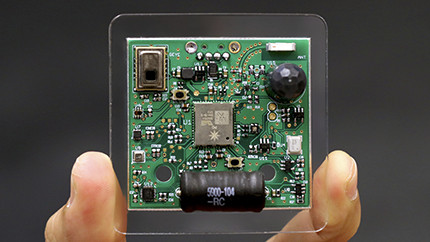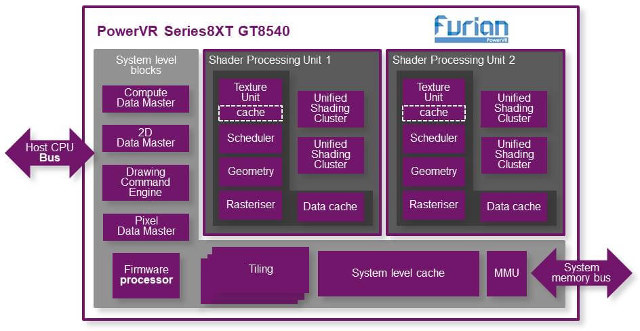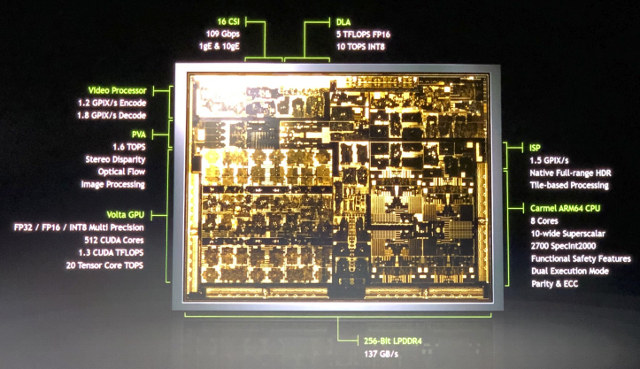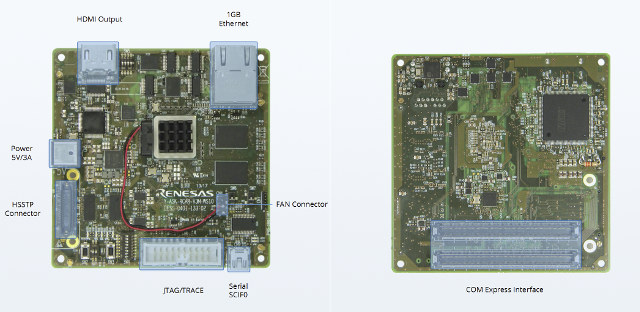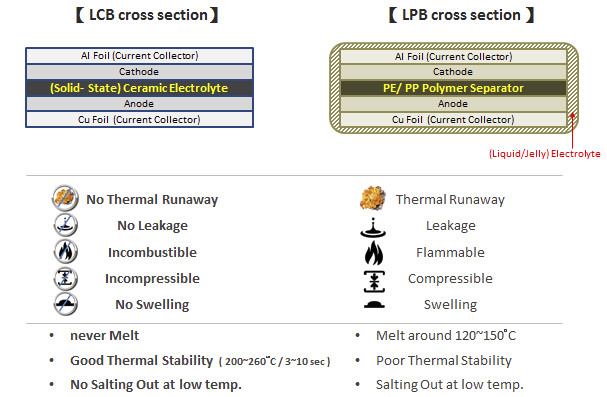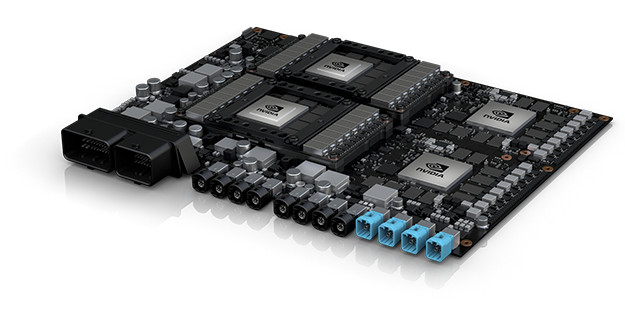Sensors can be used to get specific data for example temperature & humidity or light intensity, or you can combine an array of sensors and leverage sensor fusion to combines data from the sensors to improve accuracy of measurement or detect more complex situation. Gierad Laput, Ph.D. student at Carnegie Mellon University, went a little further with what he (and the others he worked with) call Synthetic Sensors. Their USB powered hardware board includes several sensors, whose data can then be used after training through machine learning algorithms to detect specific events in a room, car, workshop, etc… List of sensors in the above board (at frequency at which data is gathered): PANASONIC GridEye AMG8833 IR thermal camera (10 Hz) TCS34725 color to digital converter (10 Hz) MAG3110F magnetometer (10 Hz) BME280 temperature & humidity sensor, barometer (10 Hz) MPU6500 accelerometer (4 kHz) RSSI data out of 2.4 GHz WiFi […]
Imagination PowerVR Series8XT GT8540 GPU Can Drive up to Six 4K Screens, Supports Hardware Virtualization
Imagination Technologies introduces PowerVR Furian architecture last year with improved performance, power and density, as well as dual cluster PowerVR Series8XT GT8525 GPU based on the new architecture, and targeting high-end smartphones, virtual reality and automotive products. The company has now introduced a quad cluster Furian GPU called PowerVR Series8XT GT8540 that can simultaneously drive up to six 4K screens at 60fps thanks to an 80% fillrate density improvement, and supports virtualization providing separation of services and applications. The new GPU mostly targets the automotive market with some new cars now requiring multiple screen support with high resolution displays for cluster, Head-Up Display (HUD) and infotainment. Hardware virtualization is equally important for automotive application, as you’ll want to separate safety-critical code, from infotainment applications for example, so if the latter crashes, the safety-critical code can still run unhindered. Each would run on separate shaders processing unit, with up to 8 […]
NVIDIA Xavier AI SoC Now Sampling, DRIVE IX & DRIVE AR SDKs Announced
Well over a year ago, NVIDIA introduced Xavier, their next generation self-driving and artificial intelligence processor, with eight custom ARM cores, a 512-core Volta GPU, and support for 8K video encoding and decode. A few months ago, the company provided some more details and unveiled NVIDIA DRIVE PX Pegasus A.I. computer for level 5 autonomous driving with two Xavier processors and two NVIDIA next-generation GPUs delivering a total 320 TOPS of computing power. For that it’s worth, 320 TOPS is about 3200 times more powerful than Intel Movidus Neural Network Compute Stick. CES 2018 has now started, and NVIDIA made several announcement related to gaming and automotive markets, and confirmed Xavier is now sampling to select customers. What’s really new from the announcement is the addition of two new SDKs (software development kits) for the processor beside the original NVIDIA DRIVE AV autonomous vehicle platform: DRIVE IX – Intelligent experience […]
Renesas R-Car M3 Starter Kit is Designed for ADAS Applications
Most boards targeting the automotive market are impossible to purchase by individual, so last year I was pleasantly surprised when I discovered Renesas R-Car M2 Porter Linux automotive infotainment development board was available for sale on Digikey, and had good documentation on eLinux.org. The company has now introduced another automotive board, namely R-Car V3M starter kit, that’s not designed for infotainment, but instead for ADAS (Advanced Driver Assistance Systems) or even AD (Automated Driving) applications. Specifically, the board is supposed to “accelerate the development of New Car Assessment program (NCAP), front camera applications, surround view systems, and lidars” leveraging the company’s R-Car V3M image recognition SoC. Renesas R-Car V3M starter kit (V3MSK) specifications: SoC – Renesas R-Car V3M processor with two Cortex A53 64-bit cores @ up to 800 MHz, a dual lockstep Cortex-R7 32-bit core @ up to 800 MHz, IMP-X5-V3M image recognition engine System Memory – 448KB RAM on-chip; […]
Prologium Lithium Ceramic Solid State Batteries Don’t Catch Fire, Nor Explode
You must have read articles or watch videos showing laptop or smartphone battery explode, and Lithium-ion batteries are considered hazardous enough that they are banned from airplane without the proper paper work. Such batteries can catch fire or even exploded when overcharged, or physically damaged. We have protection circuits for the former, and physical damage seldom happens, so in most cases the batteries are safe, and that’s why they are still used in laptops and phones. However, if you need maximum safety, Lithium ceramic battery (LCB) may be the way to go. Those are still Lithium-ion battery cells, but they replace the liquid polymer separator found in Li polymer battery (LPB) by a solid-state ceramic electrolyte, and you can mistreat them almost as much as you like with overcharge, cut them, bend them, and they won’t catch fire, nor explode. One company that makes such batteries is Taiwan based Prologium […]
NVIDIA DRIVE PX Pegasus Platform is Designed for Fully Autonomous Vehicles
Many companies are now involved in the quest to develop self-driving cars, and getting there step by step with 6 levels of autonomous driving defined based on info from Wikipedia: Level 0 – Automated system issues warnings but has no vehicle control. Level 1 (”hands on”) – Driver and automated system shares control over the vehicle. Examples include Adaptive Cruise Control (ACC), Parking Assistance, and Lane Keeping Assistance (LKA) Type II. Level 2 (”hands off”) – The automated system takes full control of the vehicle (accelerating, braking, and steering), but the driver is still expected to monitor the driving, and be prepared to immediately intervene at any time. You’ll actually have your hands on the steering wheel, just in case… Level 3 (”eyes off”) – The driver can safely turn their attention away from the driving tasks, e.g. the driver can text or watch a movie. The system may ask […]
Linaro Connect SF 2017 Welcome Keynote – New Members, Achievements, the Future of Open Source, and More…
Linaro Connect San Francisco 2017 is now taking place until September 29, and it all started yesterday with the Welcome Keynote by George Grey, Linaro CEO discussing the various achievements since the last Linaro Connect in Budapest, and providing an insight to the future work to be done by the organization. The video is available on YouTube (embedded below), and since I watched it, I’ll provide a summary of what was discussed: Welcoming New Members – Kylin (China developed FreeBSD operating systems) joined LEG (Enterprise Group), NXP added LHG (Home Group) membership, and Xilinx joined LITE (IoT and Embedded). Achievements OPTEE open portable trusted environment execution more commonly integrated into products. Details at optee.org. LEG 17.08 ERP release based on Linux 4.12, Debian 8.9 with UEFI, ACPI, DPDK, Bigtop, Hadoop, etc… LITE group has been involved in Zephyr 1.9 release, notably contributing to LwM2M stack More projects to be found […]
Mictrack MT600 4G GPS Tracker Supports Traccar, OpenGTS, and Other GPS Tracking Platforms
Cellular GPS trackers have been around for a few years, but so far mostly 2G or 3G GPS trackers with products like Ping, Particle Asset tracker, and many other models selling on Aliexpress. 4G GPS tracker have been less common. However, recently we’ve seen platforms like Wio LTE and AutoPi that could handle GPS tracking over LTE connectivity, and another alternative would be Mictrack MT600 that ready-to-use solution to track your car or other vehicle with GPS and 4G. Mictrack MT600 hardware specifications: GNSS U-BLOX7 GPS Chip GPS sensitivity -162dBm Channel – 56 Positioning Accuracy – 10m Cold start: 30s; warm start: 15s; hot start: 1s SMA antenna connector Cellular Connectivity Qualcomm 4G LTE chip MT600-A model (North America): 4G FDD LTE: 700/850/1700/1900MHz 3G UMTS: 850/1700/1900MHz GSM: 850/1900MHz MT600-C model (Asia): 4G FDD LTE: 900/1800/2100MHz 4G TDD LTE: 1900/2300/2500/2600MHz 3G UMTS: 900/2100MHz GSM: 900/1800MHz MT600-E (Australia/Asia/Europe) 4G FDD LTE: 800/850/900/1800/2100/2600MHz 3G […]


